21 Inspiring Montessori Room Ideas for Creative Spaces
Creating a Montessori-inspired room can completely transform your child’s learning experience, fostering independence and creativity. Here are 21 practical and engaging room ideas that blend functionality with playful design, ensuring a space where kids can explore, learn, and grow at their own pace.
Open Shelving for Easy Access
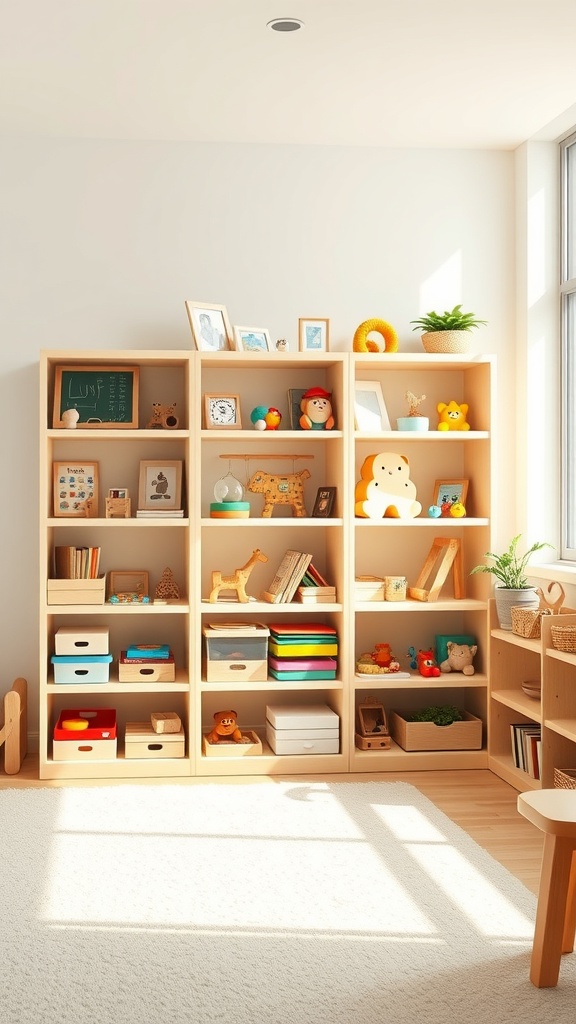
Open shelving is a fantastic choice for a Montessori room. It allows children to see and reach their materials easily. This setup encourages independence and decision-making.
The image shows a well-organized shelf filled with colorful toys, books, and learning materials. Each item is visible, making it simple for kids to choose what they want to play with or learn.
Using baskets and boxes helps keep things tidy while still being accessible. Children can learn to put things back in their place, promoting responsibility.
Natural light streaming in adds warmth to the space, making it inviting. This kind of environment fosters curiosity and exploration, key aspects of the Montessori approach.
Art Corner for Creative Expression
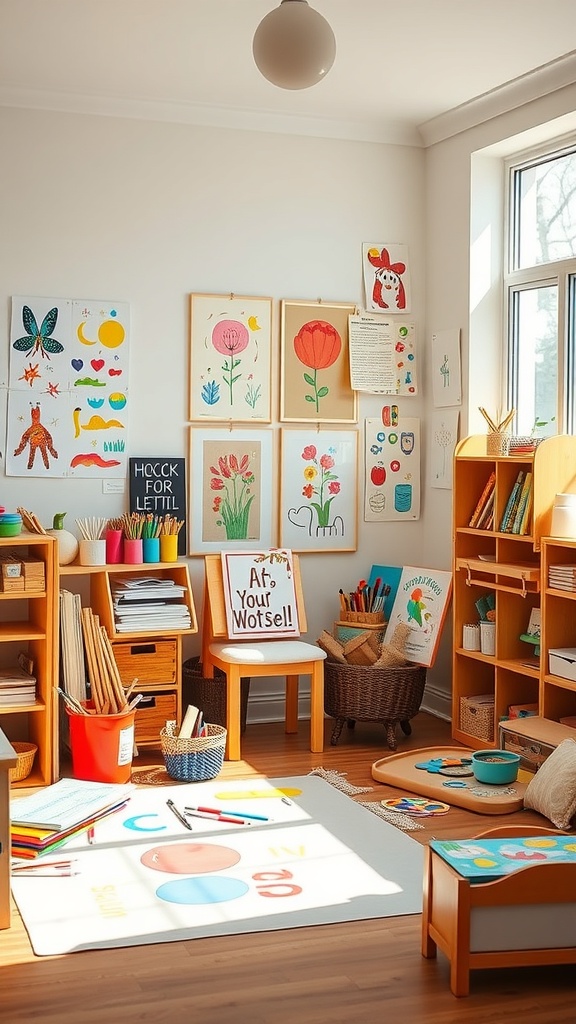
Creating an art corner in a Montessori room is a fantastic way to encourage creativity. This space should be bright and inviting, filled with various art supplies. In the image, you can see colorful drawings displayed on the walls, showcasing children’s creativity. These artworks not only add color but also inspire other kids to express themselves.
The setup includes shelves filled with art materials like colored pencils, paper, and paints. Having easy access to these supplies allows children to explore their artistic side freely. The cozy seating area invites them to sit down and get creative.
Notice the playful rug on the floor, which adds comfort and a fun element to the space. This encourages kids to sit on the floor and engage in their artistic projects. An art corner like this promotes hands-on learning and helps children develop fine motor skills while having fun.
Child-Sized Furniture for Independence
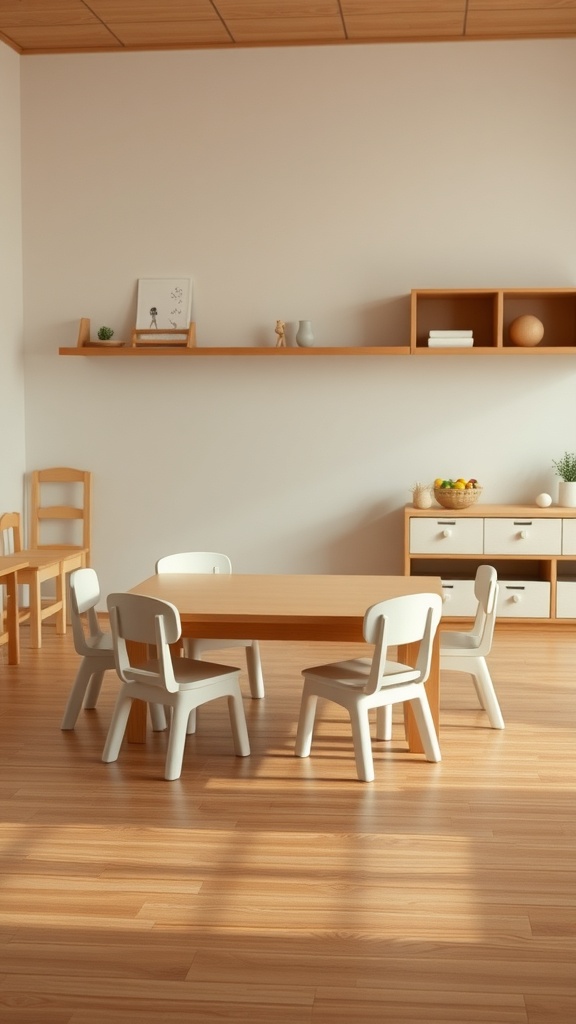
Child-sized furniture is a key element in a Montessori room. It encourages kids to be independent and confident. When children have their own chairs and tables, they can easily access their materials and engage in activities.
The image shows a simple setup with a wooden table and matching chairs. This design is not just functional; it creates a welcoming space for children. The light wood tones add warmth and make the room feel inviting.
Having furniture at their height allows kids to move freely and make choices. They can sit down, get up, and interact with their environment without needing adult help. This fosters a sense of responsibility and ownership over their learning.
Incorporating child-sized furniture can transform any room into a space where kids feel empowered. It’s a small change that can lead to big growth in their independence.
Practical Life Skills Station
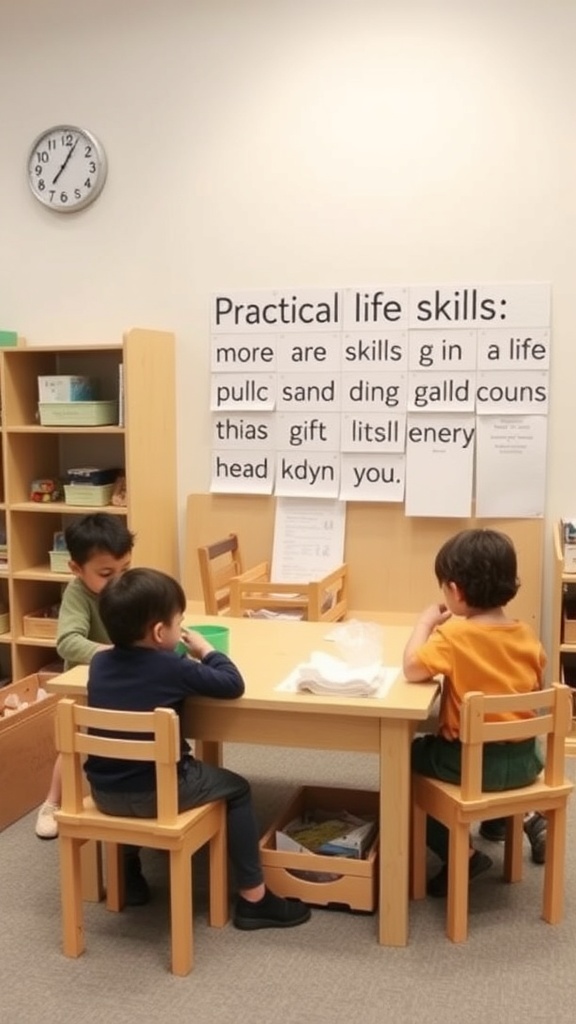
The Practical Life Skills Station is a key part of any Montessori room. It encourages children to engage in everyday tasks that promote independence and confidence. In the image, we see a cozy setup where kids are actively participating in hands-on activities.
The children are seated at a small table, focused on their tasks. This setup allows them to practice skills like pouring, sorting, and cleaning. These activities are not just fun; they help develop fine motor skills and concentration.
On the wall, there’s a clear display about practical life skills. It highlights the importance of these activities in daily life. This visual aid helps children understand what they are learning and why it matters.
Creating a space like this in your home or classroom can make a big difference. It encourages kids to take initiative and learn through play. A Practical Life Skills Station is a wonderful way to support their growth and development.
Sensory Play Areas for Exploration
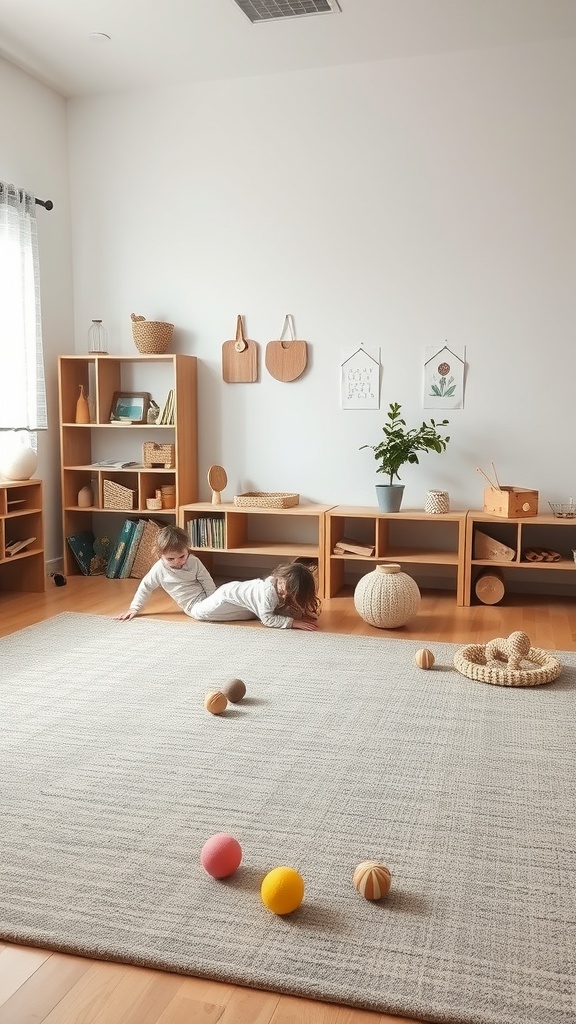
Creating a sensory play area is a fantastic way to encourage exploration and learning. In the image, two children are engaged in play, surrounded by a variety of colorful balls and soft textures. This setup invites them to touch, roll, and interact with the objects, which is essential for their sensory development.
The room features natural materials and a clean design, making it a calming space for kids. The wooden shelves hold books and baskets, promoting organization and easy access to learning materials. This encourages independence, allowing children to choose their activities freely.
Incorporating sensory play items like different textured balls can enhance fine motor skills and hand-eye coordination. The soft rug provides a safe area for movement, making it perfect for crawling and exploring. Overall, this sensory play area is designed to spark curiosity and foster a love for learning through hands-on experiences.
Quiet Reading Nook for Focused Learning
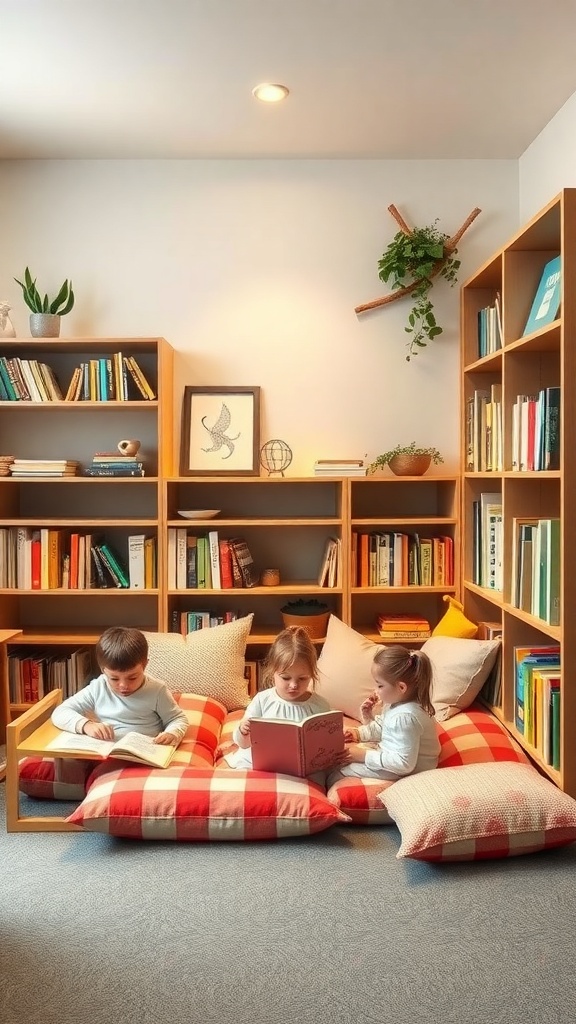
A quiet reading nook is a fantastic addition to any Montessori room. This cozy space encourages children to dive into books and explore their imaginations. In the image, we see three kids comfortably seated on soft, oversized cushions, surrounded by shelves filled with colorful books. The inviting setup makes reading feel like a fun activity rather than a chore.
The arrangement of cushions creates a relaxed atmosphere, perfect for focused learning. Each child is engaged with their own book, showcasing how this nook promotes independent reading. The natural light and simple decor enhance the calming vibe, making it an ideal spot for kids to concentrate.
Incorporating a reading nook like this in your Montessori space can inspire a love for reading. It’s important to choose comfortable seating and a variety of books to cater to different interests. With the right setup, children will find joy in learning through literature.
Natural Materials for a Warm Atmosphere

Creating a Montessori room with natural materials brings a cozy and inviting feel. The image showcases a space filled with wooden furniture and soft textures. The warm tones of the wood create a calming environment, perfect for little ones to explore and learn.
Notice the variety of toys and decor made from natural materials. These items not only look great but also encourage sensory play. Children can touch, feel, and interact with their surroundings, which is key in a Montessori setting.
The plants hanging from the ceiling add a touch of life to the room. Greenery can enhance mood and promote a sense of tranquility. Incorporating plants is a simple way to connect children with nature.
Overall, this room design emphasizes simplicity and warmth. It shows how natural materials can create a nurturing space that supports a child’s growth and curiosity.
Incorporating Nature into the Learning Space
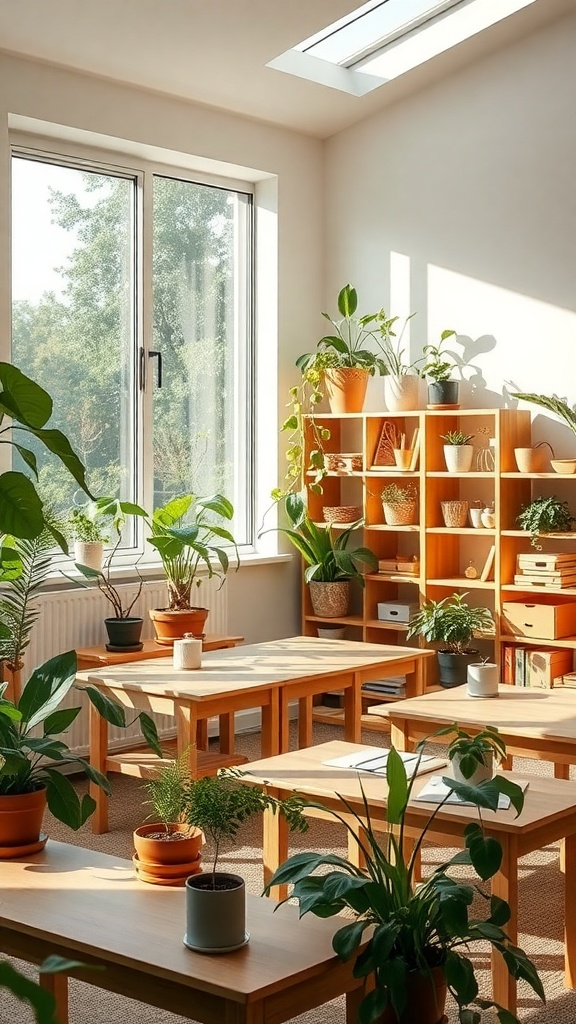
Bringing nature indoors can create a calming and inspiring environment for children. The image shows a bright, airy room filled with various plants. Sunlight streams in through the large windows, highlighting the greenery and creating a warm atmosphere.
Plants not only beautify the space but also improve air quality. They can spark curiosity and teach kids about biology and responsibility. Each plant can be a small project for children to care for, helping them learn about growth and nurturing.
The wooden tables and shelves complement the natural theme, providing a cozy and inviting area for learning. This setup encourages exploration and creativity, making it an ideal Montessori space.
Incorporating nature into the learning environment can enhance focus and reduce stress. It’s a simple yet effective way to create a more engaging and enriching experience for young learners.
Movement Space for Active Learning
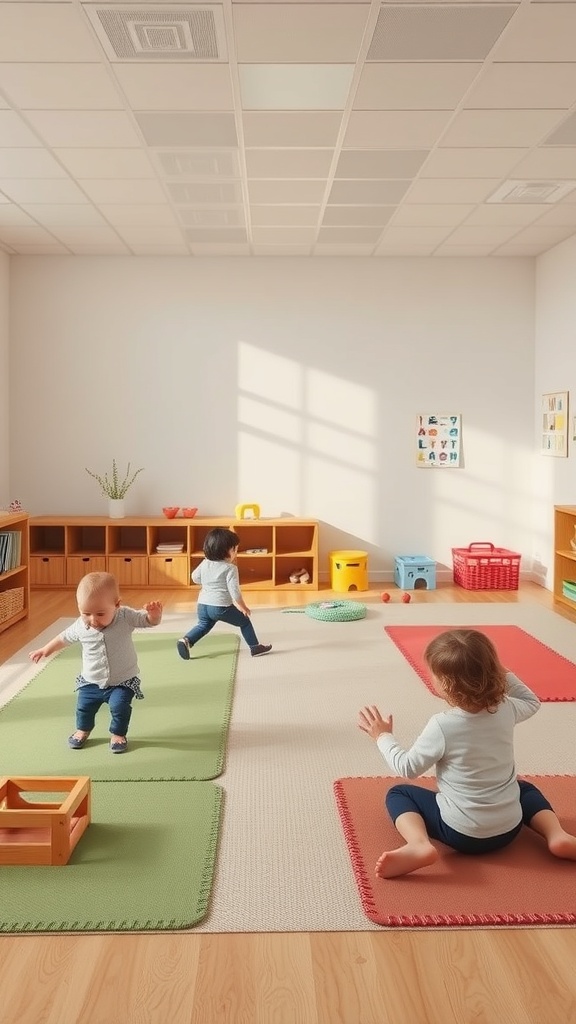
Creating a movement space is key in a Montessori room. This area encourages children to explore and learn through physical activity. The image shows a bright, open space filled with soft mats and engaging toys.
In the picture, you can see children happily moving around. One child is running, while another is sitting and playing. This setup allows them to express themselves freely. The colorful mats provide comfort and safety as they play.
Having a designated area for movement helps kids develop coordination and balance. It also promotes social interaction as they engage with each other. This kind of environment supports their natural curiosity and desire to learn.
Incorporating elements like soft mats and varied textures can make the space inviting. It’s all about creating a fun and safe area where children can thrive.
Colorful Learning Materials for Engagement
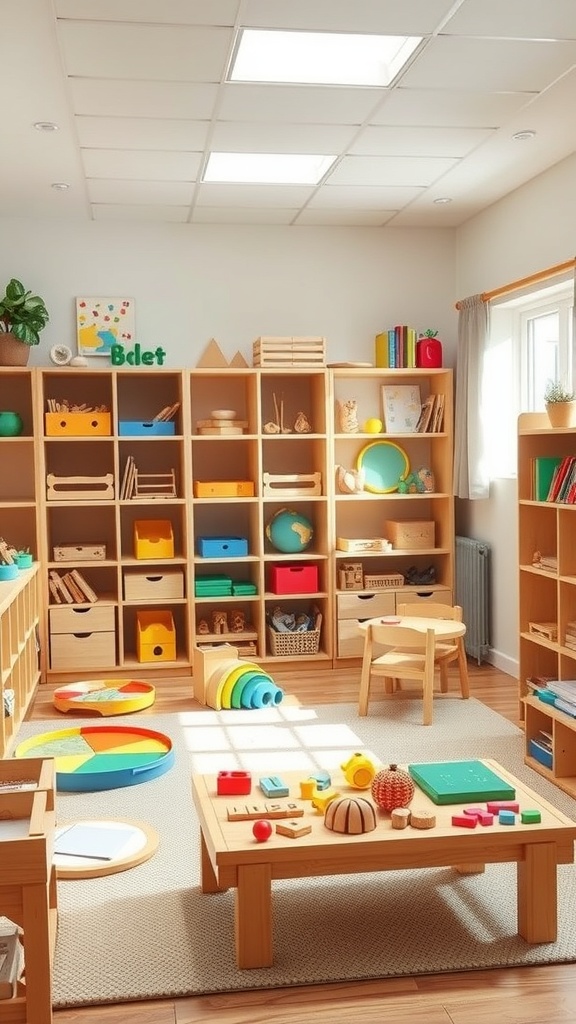
In a Montessori room, colorful learning materials play a key role in sparking curiosity and engagement. The image showcases a bright and inviting space filled with various educational toys and tools. Each item is carefully designed to encourage hands-on learning.
The shelves are lined with neatly organized materials, including blocks, puzzles, and art supplies. These items not only attract children’s attention but also promote exploration and creativity. The vibrant colors stimulate the senses, making learning feel like a fun activity.
On the floor, you can see different shapes and patterns that invite children to interact. This setup encourages them to learn through play, which is essential in a Montessori environment. The layout is open and accessible, allowing kids to choose their activities freely.
Overall, this colorful arrangement fosters a love for learning and helps children develop important skills in a playful way. It’s a perfect example of how thoughtful design can enhance educational experiences.
Flexible Layout for Individual Learning
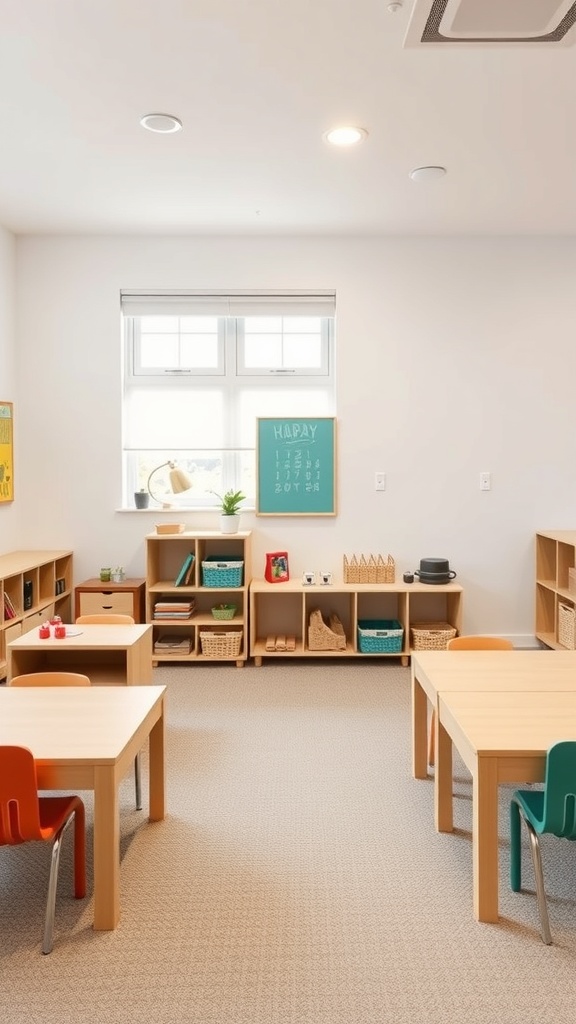
A flexible layout is key in a Montessori room. It allows children to choose their own activities and work at their own pace. The image shows a bright, inviting space with simple wooden tables and colorful chairs. This setup encourages independence and exploration.
The arrangement of furniture is open, making it easy for kids to move around. They can easily transition from one activity to another. This freedom helps them develop decision-making skills. The shelves are neatly organized, showcasing various materials that spark curiosity.
Natural light floods the room, creating a warm atmosphere. This light is essential for a positive learning environment. The overall design promotes a sense of calm, allowing children to focus on their tasks. A flexible layout not only supports individual learning but also fosters a sense of community among students.
Cultural and Diversity Displays
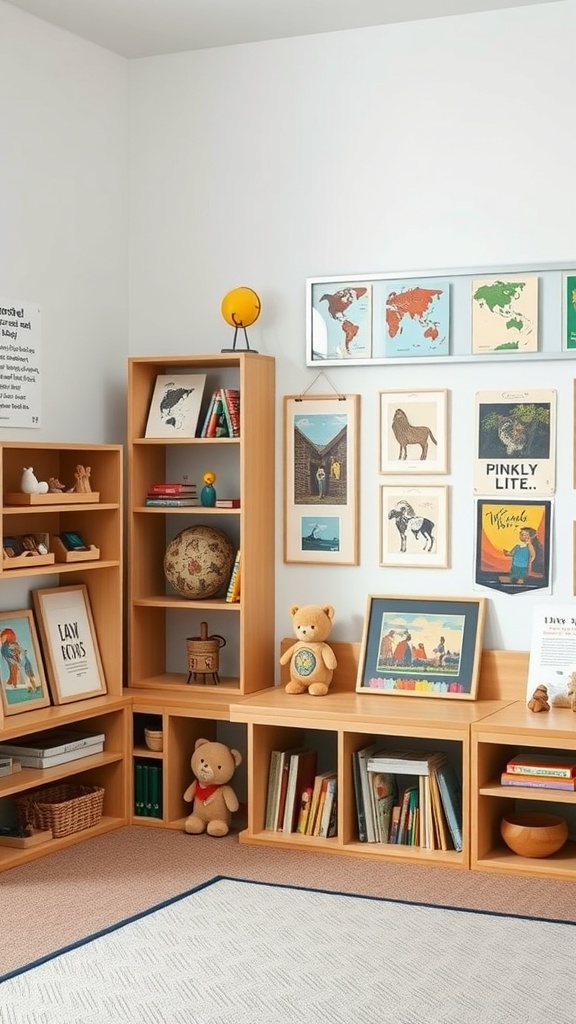
Creating a space that reflects cultural diversity is a wonderful way to enrich a Montessori room. The image shows a cozy corner filled with books, art, and toys that celebrate different cultures. This setup invites children to learn about the world around them.
On the walls, you can see framed maps and colorful prints that showcase various cultures. These visuals spark curiosity and encourage discussions about different places and traditions. The globe on the shelf adds a fun touch, making geography relatable and exciting.
Books are neatly arranged, offering stories from various backgrounds. This encourages children to explore different narratives and perspectives. The presence of soft toys, like the teddy bears, makes the space welcoming and comforting, inviting children to engage with the materials.
Overall, this display not only beautifies the room but also serves as a tool for teaching respect and appreciation for diversity. It’s a great way to foster an inclusive environment where every child feels valued.
Personalized Learning Spaces
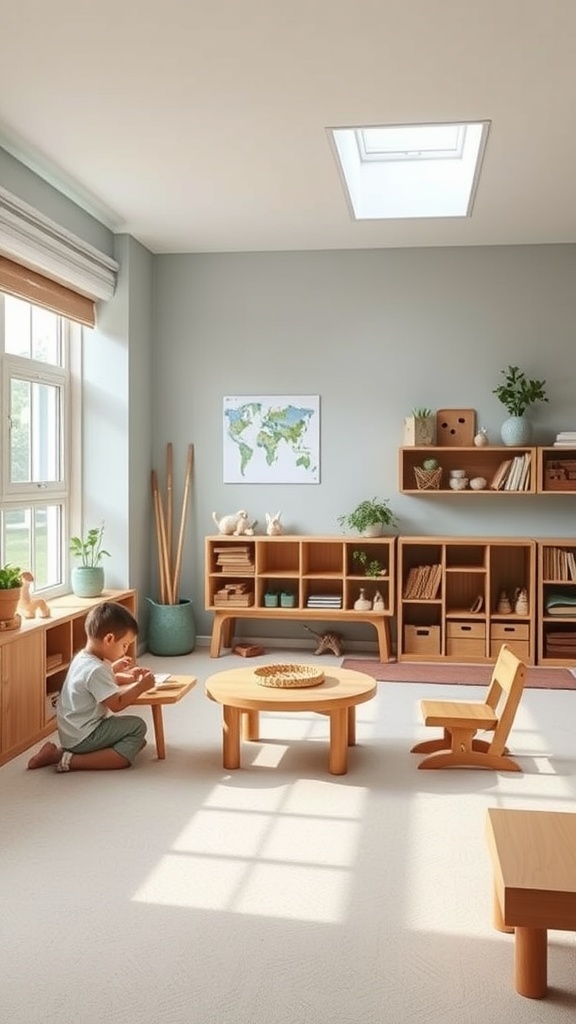
Creating personalized learning spaces is key in a Montessori environment. The image shows a cozy room designed for young learners, filled with natural light and simple furniture. This setup encourages children to engage in activities that suit their interests.
The child in the picture is focused on a small table, which is perfect for hands-on learning. This kind of space allows kids to explore at their own pace. The low tables and chairs are designed for comfort and accessibility, making it easy for children to move around and choose their activities.
Storage is also important in this room. The open shelves display various materials, inviting kids to pick what they want to work with. This promotes independence and decision-making skills. The world map on the wall adds an educational touch, sparking curiosity about different cultures and places.
Overall, this personalized learning space reflects the Montessori philosophy, emphasizing freedom, exploration, and a love for learning.
Outdoor Learning Environment

Creating an outdoor learning environment is a fantastic way to engage children with nature. The image showcases a beautifully arranged space filled with wooden furniture and plants, perfect for hands-on activities.
The setup includes a low table surrounded by small chairs, inviting kids to gather around for play or learning. The natural materials used in the furniture blend seamlessly with the greenery, making the area feel welcoming and cozy.
Incorporating elements like potted plants and natural textures encourages exploration. Children can learn about different plants, observe insects, or even engage in simple gardening tasks. This kind of environment supports creativity and curiosity.
Having a designated outdoor space allows for a variety of activities, from art projects to storytelling sessions. It’s a place where kids can connect with their surroundings and learn through play. This setup is an excellent example of how to create an enriching outdoor learning environment.
Incorporating Technology Mindfully
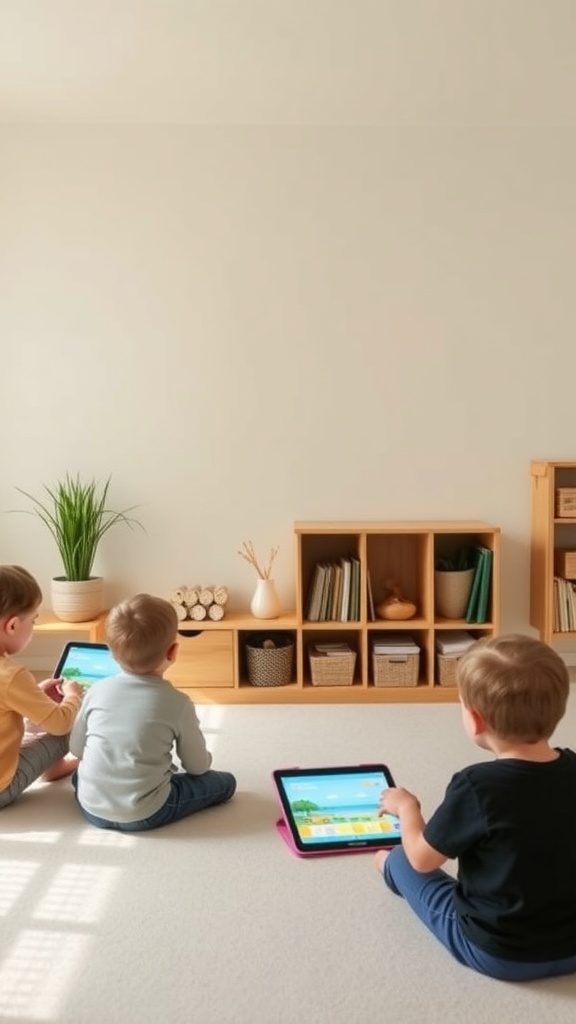
In a modern Montessori room, technology can play a helpful role. The image shows three children engaged with tablets, showcasing how digital tools can support learning. Each child is focused, suggesting that technology can be a part of their educational journey.
When using tablets or other devices, it’s important to choose educational apps that align with Montessori principles. Look for interactive programs that encourage creativity and problem-solving. This way, children can explore and learn at their own pace.
Setting boundaries is key. Limit screen time to ensure kids also engage in hands-on activities. Balance is essential to foster a well-rounded learning environment. Encourage outdoor play and tactile experiences alongside digital learning.
Incorporating technology mindfully can enhance a Montessori room. It can spark curiosity and support independent learning while still promoting essential life skills.
